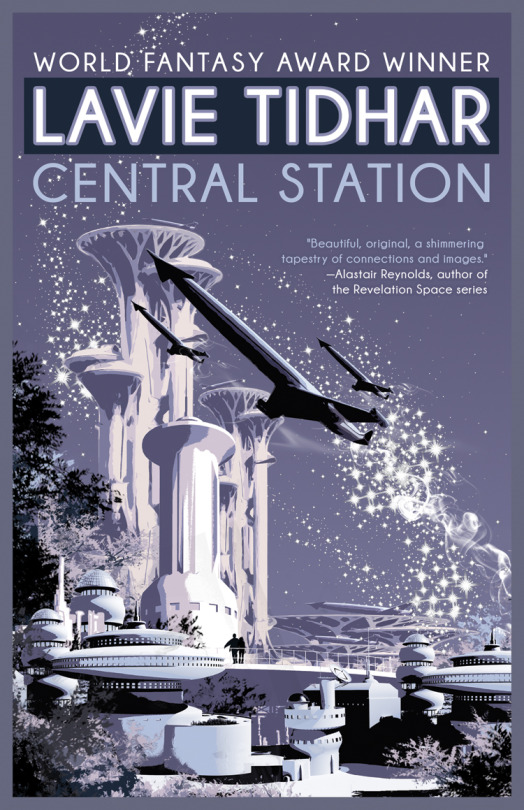CENTRAL STATION is a world imbued with life beyond the service of a single narrative arc
Today (6/10) is the official publication day of Lavie Tidhar’s beautiful CENTRAL STATION and the positive feedback keeps coming.

(Photo: Kevin Nixon. © Future Publishing 2013.)
At ARS TECHNICA, Rachel Acks praises the novel’s unconventionally, among other things.
The scope of Lavie Tidhar’s new novel CENTRAL STATION may be galactic, but each of its many, many co-existing layers of reality are connected by one locale: the ever-present space port of Central Station, an unimaginably massive building that joins the human past on Earth to its rapidly evolving future. Trying to summarize CENTRAL STATION is like trying to summarize an entire season of a soap opera, except there are no heroes or villains, and, you know, the plot’s mysterious baby scandal is about who engineered him in the vat and to what purpose. Adding to the drama is the Conversation: an inescapable, interconnected network that touches (almost) all people throughout the space-time continuum.
CENTRAL STATION grew out of 13 linked short stories, some previously published and some new, which is what grants World Fantasy Award-winning author Tidhar such a broad canvas. His interwoven mix of human and non-human lives is full of characters crashing into the world and sending out ripples like stones thrown into a pond.

Mechanically, Tidhar’s skill with prose adds to the organic riot. The world of the Central Station is vital with sound, smell, and color (with its mixture of the ancient and the speculatively new, Tel Aviv is the perfect address for Central Station). In just a few words, Tidhar can give every character and place a history. It would be nice, however, if he didn’t leave so many of his well-crafted paragraphs hanging from ellipses or severed in their prime by em dashes.
Yet CENTRAL STATION’s weaknesses add up to strengths. The episodic nature of the chapters may feel unsatisfying and unfocused, and the way story-spanning plot strands can finish mid-book might leave a reader unbalanced. On the other hand, the escape from more traditional (and commercial) story structure allows the Central Station to be a place where the extraordinary and alien are commonplace, its world imbued with life beyond the service of a single narrative arc. Messiahs come and go and don’t require a massive build-up and a crashing finale.
Characters live without rising and falling action, because life has never been a three-act narrative. The true main characters of the story, around whom the world revolves inscrutably—Central Station itself and the Conversation—are too expansive, new, and inhuman for traditional narratives to contain.
Gay K. Wolfe for LOCUS ONLINE lauds Lavie Tidhar and CENTRAL STATION.
In good linked-story tradition, minor characters in one story become major characters in another, and the overall tapestry that emerges attains a persuasive unity, even if it’s not quite a novel. The stories include some of Tidhar’s most beautiful prose, and his future Tel Aviv is among the most evocative settings in recent SF, not least because Tidhar, rather wisely, refrains from expanding the point of view to, for example, the Martian colonies (readers interested in checking those out might want to read Tidhar’s Martian Sands). Somehow, Central Station combines a cultural sensibility too long invisible in SF with a sensibility which is nothing but classic SF, and the result is a rather elegant suite of tales.

John DeNardo at KIRKUS, Andrew Wheeler of THE ANTICK MUSINGS
OF G.B.H. HORNSWOGGLER, GENT., and Marty Halpern on his MORE RED INK all recommend the then-forthcoming book.
WHY YOU MIGHT LIKE IT: As he stated in this interview, this collection is rooted in real-world history, serves as a love letter, and offers us a hopeful future.
THE ANTICK MUSINGS OF G.B.H. HORNSWOGGLER, GENT.:
I’m leading off with Lavie Tidhar’s CENTRAL STATION because I keep thinking I need to start reading his books. He’s won the World Fantasy Award, the British SF award, and he’s got one of the great names in modern literature. This one is his fourth novel, either a fix-up of some of his “Central Station” stories or a brand-new story set in the same world – I don’t know yet myself, since (as I noted) I haven’t actually read any Tidhar yet. But this is about some people at the base of what seems to be a beanstalk in near future Tel Aviv, and is available right now as a trade paperback from Tachyon.
I included a couple excerpts from the book itself in that November 30 blog post; and you can access the publisher’s website – Tachyon Publications – to read the starred Publishers Weekly review and the starred Library Journal review.
What I want to include here this time around is some thoughts on the book from the author himself, from Lavie Tidhar’s own blog post on July 2, 2015, announcing the sale of Central Station to Tachyon Publications:
….In a way, [Central Station] both represents everything I have to say about the shape of science fiction – and a large part of it is a sort of dialogue with older (mostly, admittedly, quite obscure) SF – and a way of talking about the present. It is set in the old central bus station area in south Tel Aviv, currently home to a quarter of a million poor economic migrants from Asia, and African refugees, and I wanted to explore that area through the lens of science fiction (one of the weird things I found recently is that the fictional sort of “federal” political vision of Israel/Palestine I have in the book is now being touted as a real solution by a group of political activists). My other ambition was to write a book which was mostly about character interaction: about extended families, about relationships, in which the “shiny” science fiction future serves as a sort of background rather than taking centre stage. My other inspiration was that I always wanted to write a novel in short stories. Science fiction has a long tradition of doing this – from The Martian Chronicles to Lord of Light – but my inspiration was also partly V. S. Naipaul’s Miguel Street.
For more info about CENTRAL STATION, visit the Tachyon page.
Cover and poster by Sarah Anne Langton
